June 24, 2022
What are assessments for phonics?
Phonics assessments are diagnostic tools that are specifically designed to provide an informal evaluation of a student’s phonics and reading skills. These assessments allow educators to identify both the skills a student has mastered and the skills a student is missing, and they can be administered to readers of all ages.
Why are phonics assessments important?
Phonics assessments allow students to demonstrate what they know about reading. Teachers can use the assessment tool in a variety of ways, choosing the areas of phonetic knowledge they will evaluate depending on the needs of their individual students.
By utilizing phonics assessment, teachers can pinpoint the strengths and deficits in their students’ phonics skills. With this clarity of phonetic knowledge, teachers can then use the data they’ve collected to:
- Determine where to begin phonics instruction
- Decide the type of intervention to implement for a specific class or an individual student
Phonics assessments are useful tools for various types of educators at all levels of education, including:
- Classroom teachers
- Reading specialists
- Special education teachers
- Speech-language pathologists
- Interventionists; and
- Instructional aides
This form of assessment is particularly valuable for struggling readers, including students with dyslexia.
What is the best phonics assessment?
When you’re seeking a phonics assessment tool, you want one that was created by educators and based on data collected through years of research.
The best phonics assessment is:
- Focused: Assesses the most critical phonics categories and provides error-level analysis to ensure students have mastered the phonics patterns they will need the most.
- Diagnostic: Allows teachers to see exactly where their students are struggling in their knowledge of phonics.
- Efficient: Can be easily administered on any electronic device. Enables teachers to complete a thorough screening in two to five minutes per student and receive instant educational insights—with no manual data entry required.
- Aligned: Tracks grade-level instruction and student learning throughout the school year with customized reports that align with the scope and sequence of the school’s phonics curriculum. Teachers can easily gauge their students’ needs and progress.
- Instructional: Provides easy-to-read, immediate reports that highlight skill-level insights, instructional focuses, and patterns of error. These detailed, relevant reports allow teachers and specialists to personalize instructional approaches for their students.
- Precise: Student, class, and grade-level reports give educators the tools they need to identify which skills to focus on with their individual students, small groups, whole class, or grade level.
Recently, we were thrilled to announce that Star Phonics—formerly known as KeyPhonics—has joined the Renaissance family. Created by Dr. Michelle Hosp, Star Phonics is the first and only web-based assessment to focus on the 12 most critical phonics categories and 102 phonics skills.
We recently had the opportunity to discuss Star Phonics, and the Science of Reading more generally, with Dr. Hosp, who now serves as Director of Foundational Literacy at Renaissance.
Here are the highlights from our conversation.
6 frequently asked questions about Star Phonics
#1: Why did you create Star Phonics? What sets it apart from other assessments?
Michelle Hosp: I first saw the need almost twenty-five years ago, when I was working as a school psychologist in Clark County, Nevada. Teachers would contact me about students who were struggling to read, and they’d ask, “What can I do to help this child?” I had a battery of tests that I administered, which usually confirmed what the teacher already suspected—the student was indeed struggling to decode words. Unfortunately, the tests didn’t identify the specific phonics patterns the student was struggling with, so I couldn’t provide clear guidance on how to assess phonics in the classroom.
These experiences made me realize that I wanted to be more helpful to teachers, so I decided to pursue a graduate degree focused on reading instruction and assessment. Once I received my Ph.D., I became a professor in Utah. As I worked with local teachers, I encountered the same frustration I’d seen in Clark County. They knew which students were struggling to decode words, but they didn’t have diagnostic information showing them where to focus instruction. I created the first version of Star Phonics as a pencil-and-paper assessment to help these teachers and their students.
This roughly coincided with the widespread adoption of curriculum-based measures and the Reading First initiative. There was suddenly a lot of research, especially in phonological awareness and early language skills, that identified best practices for supporting foundational literacy development. There was also a clear recognition that if we could identify struggling students early, and provide really good interventions and instruction, they could become successful readers, rather than waiting to remediate once they’d reached grade 3 or 4.
I developed Star Phonics based on this important body of research, which is now known as the Science of Reading.
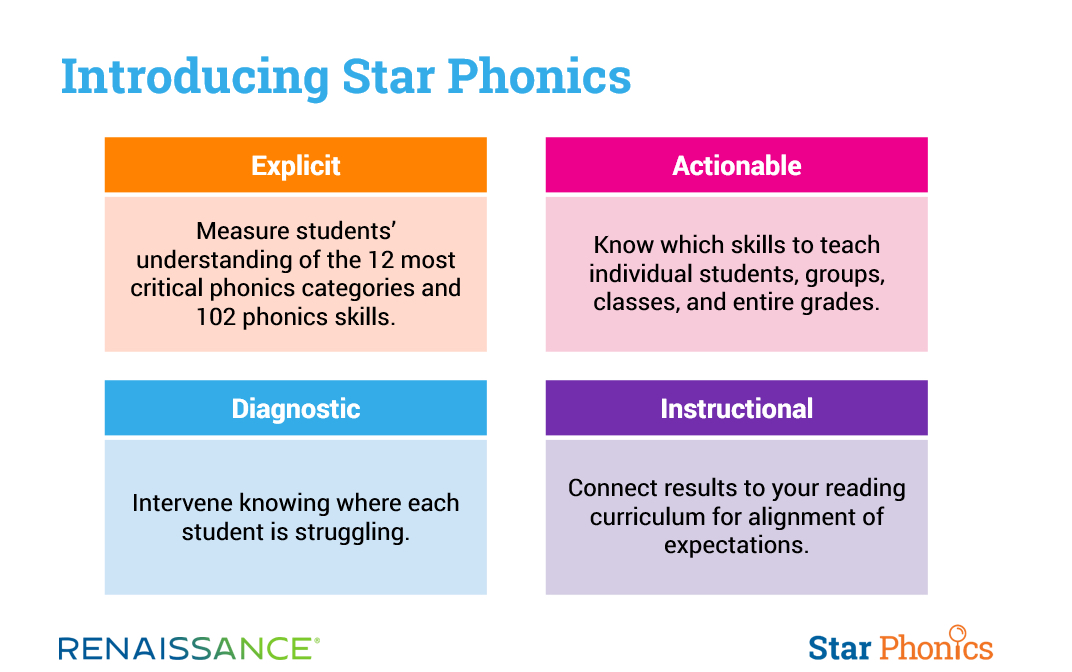
#2: How did this early version of Star Phonics evolve into the assessment that’s available today?
Michelle Hosp: Several years after I created Star Phonics, I presented my work at an educational conference. I was assigned the worst possible time slot—literally 8:00 am on the conference’s opening day—yet I had a standing-room only crowd. There were even people in the hallway, listening through the open door. After the presentation, teachers came up to me asking if they could use the assessment in their classrooms. This confirmed that the need existed, and that it made sense to invest in moving from pencil-and-paper to online administration in order to save teachers time and minimize the potential for error that comes with manual data entry.
I designed Star Phonics to be very similar to the single-word measures that are included in most CBMs, including Expressive Nonsense Words in Star CBM Reading. This means teachers do not need to learn a new process for administering and scoring Star Phonics.
Also, other phonics assessments present students with a printed sheet of up to 100 words, which can be overwhelming, especially if students are already struggling. With Star Phonics, words appear on the screen three at a time. The student reads the words aloud, and the teacher records correct and incorrect responses, along with any notes. For each word the student reads, the teacher sees a rhyming word to indicate the correct pronunciation, as shown in the example below. With the click of a button, teachers can play audio of the correct pronunciation—a feature that obviously isn’t available in pencil-and-paper format!
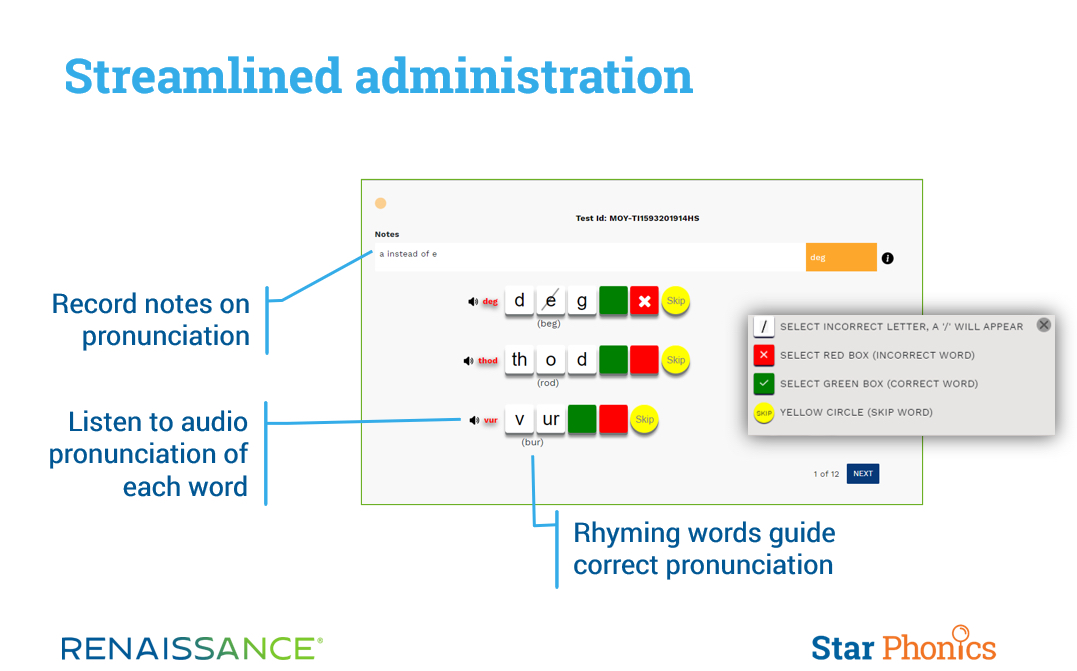
Although the test as a whole isn’t timed, students are given three seconds to read each word. This means teachers can screen an entire class in just two-three minutes per student and reporting is available immediately.
I’m sometimes asked how we identified the 12 categories and 102 skills that Star Phonics assesses. Why not eight categories, or 13? As part of the design process, we reviewed popular reading curricula and looked at the phonics patterns covered at each grade level. We then shared this list with our external advisors and they helped us identify the essential patterns, meaning those used most frequently in the words students will encounter. Thinking of digraphs, for example, it’s clear that assessing “th,” “sh,” and “wh” makes a lot of sense, given their frequency in the words students are learning in the early grades.
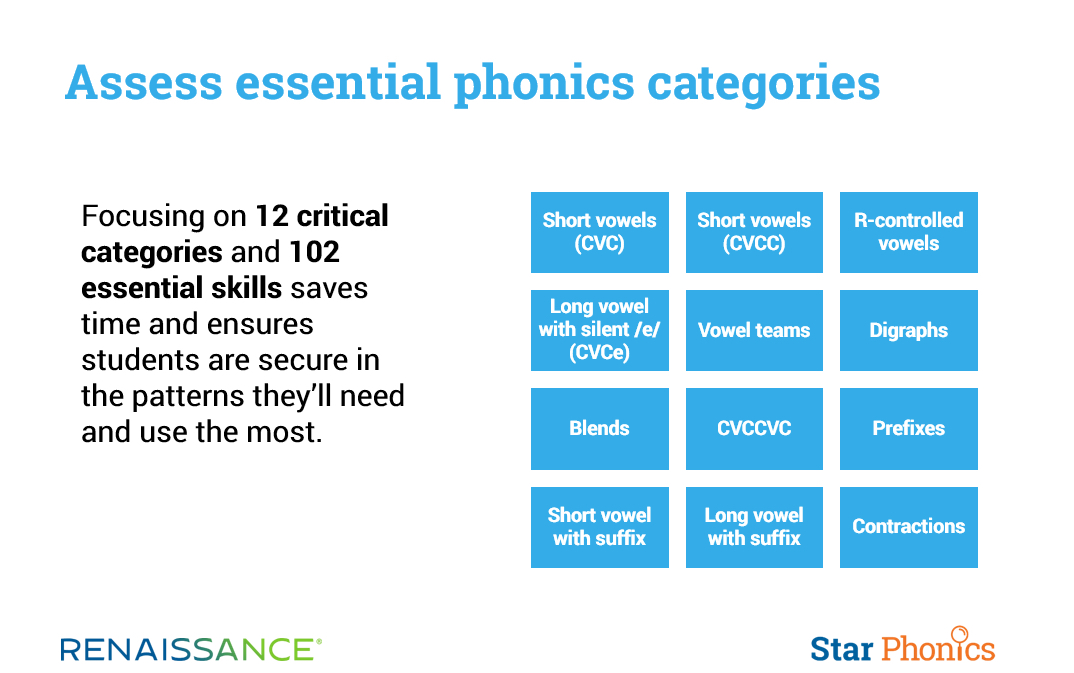
#3: How are educators using Star Phonics? How do they connect Star Phonics data to daily instruction?
Michelle Hosp: A couple of examples come to mind—the first at the classroom level and the second at the system level.
I remember delivering PD at a school that was implementing Star Phonics. One second-grade teacher clearly wasn’t convinced that she needed the assessment—she sat in the back of the room with her arms crossed, and she wasn’t engaged at all. I knew that she planned to administer Star Phonics the following morning at 9:00, so I visited her classroom around 9:30, not sure what I’d find. She was standing at the front of the room, teaching a lesson on silent /e/.
My first thought was that she hadn’t administered the assessment yet. It turned out that she’d tested all of her students at 9:00 as planned. She then reviewed the Class Matrix Report and saw that about half of the class hadn’t mastered silent /e/, which she’d taught several weeks before. She told me later that if it hadn’t been for Star Phonics, she wouldn’t have known that her students needed more work on this essential skill. She said that she hadn’t been a believer before, but she was now.
This is a pattern I’ve seen repeated over and over. Teachers aren’t necessarily excited when they hear about a new assessment, but their view changes completely when they have their students’ data in front of them and can clearly see where to focus instruction.
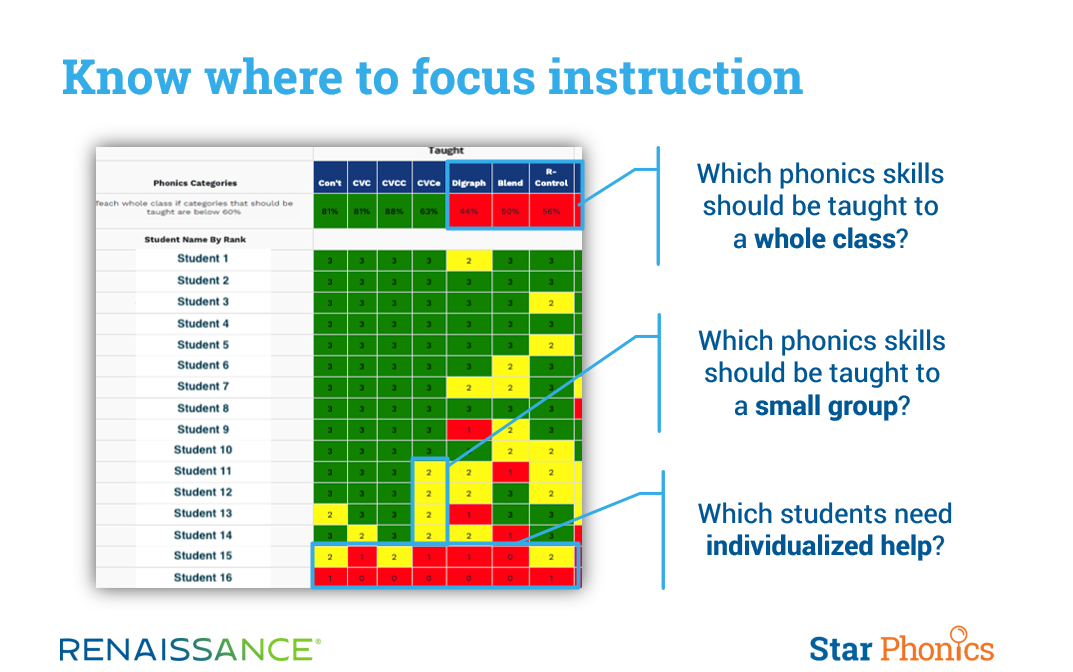
My second example is from a district-wide implementation. In this district, vowel teams were taught during the final weeks of grade 2. Unfortunately, the second-grade teachers often didn’t keep pace with the curriculum, and they rarely got to these lessons. Vowel teams weren’t part of the grade 3 curriculum, so often students never received instruction on this essential skill. Star Phonics identified this gap right away, and the district’s leaders realized they needed to create a pacing guide to ensure vowel teams would be covered.
This may sound like stating the obvious, but Star Phonics validates that when we teach phonics skills explicitly and systematically, and when we give kids opportunities to respond and practice, they learn the skills. The opposite is also true. When we don’t teach phonics skills such as vowel teams, students rarely pick them up on their own.
#4: How does Star Phonics align with a district’s curriculum?
Michelle Hosp: I mentioned earlier that we reviewed popular reading curricula when we were creating Star Phonics and found many similarities in terms of the phonics patterns they cover. The key differences involve the grade level at which specific patterns are taught. For example, r-controlled vowels are covered in grade 2 in some curricula and grade 3 in others.
We want to ensure that Star Phonics reports reflect these differences, as shown in the example below. Star Phonics currently aligns with widely used curricula such as:
- Benchmark Education
- Wonders
- Journeys
- Orton-Gillingham
- Reading Street
- And more
We also do custom alignments, including for curricula districts have created on their own.
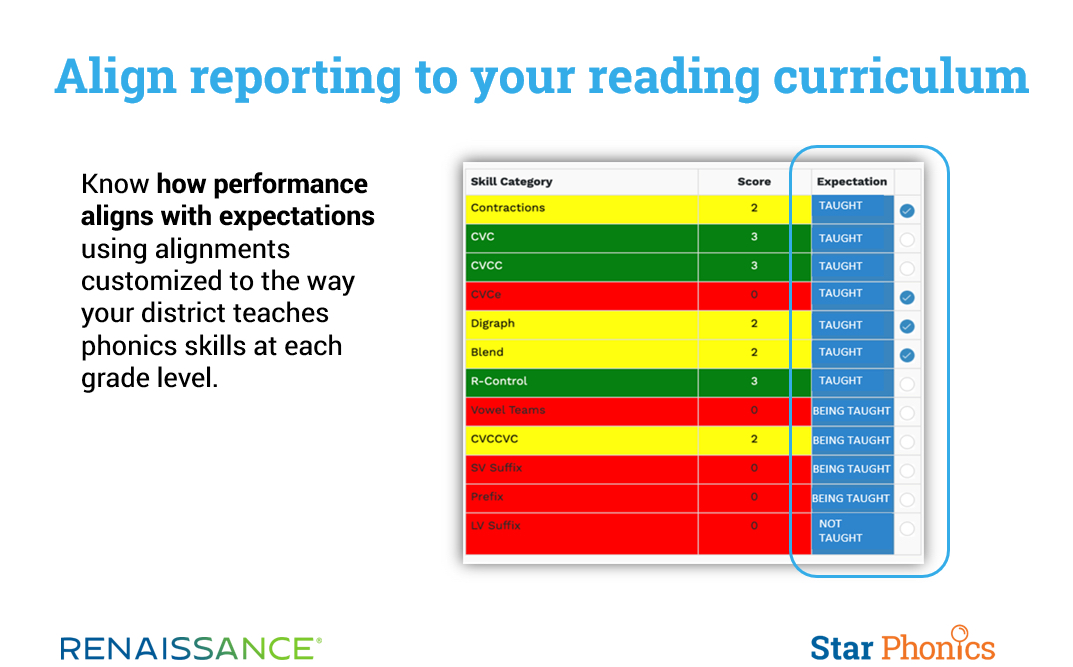
I’m sometimes asked whether Star Phonics can be used in middle and high school, and the answer is: Absolutely!
In one of our first implementations, the principal made it clear that she expected the assessment to be administered to every student in the building. The teachers in grades 4 and 5 were surprised by this. They didn’t think of themselves as phonics teachers. In their minds, reading instruction involved comprehension and vocabulary, not sounds and letter patterns and sight words. But we know from the Science of Reading that phonics is half of the equation, and there can be no comprehension unless students can recognize and decode words.
The principal made it clear she expected teachers to serve all the students in their classrooms, including the struggling readers. This led to some successful collaboration, with the teachers in grades 4 and 5 partnering with colleagues in the earlier grades to plan phonics instruction.
#5: How might educators use Star Phonics alongside other Renaissance programs?
Michelle Hosp: Most schools use Star Phonics alongside a reading screener such as Star Reading or Star CBM Reading. The screener shows how students are performing on an array of reading skills and which skills students are struggling with. Star Phonics helps educators to then narrow the focus by identifying the specific patterns to teach next.
This is an important differentiator between Star Phonics and other phonics assessments. Both will show you, for example, that students are having trouble with short vowels. But only Star Phonics shows you which short vowels to reteach, which is a tremendous time-saver.
Joining Renaissance allows us to identify additional opportunities for saving teachers time. For example, we know teachers use their Star Phonics data to plan lessons, create worksheets, and choose decodables from the library—all of which take time. But by taking advantage of the instructional content in Renaissance programs, we can help to streamline this process. I’m thinking particularly of the foundational literacy lessons available in Lalilo and the many instructional resources embedded in Star Reading. There’s a lot that we can do, and I’m excited to get started.
#6: The COVID-19 pandemic greatly impacted foundational literacy development. How does Star Phonics help districts to address this?
Michelle Hosp: In a way, the pandemic disruptions validated what many of us have known all along: when it comes to learning how to read, teachers are indispensable. I recognize districts made tremendous efforts to ensure learning continued when buildings were closed, and I don’t want to discount this. But teaching children to read is a complex task that takes years, even under the best circumstances. When you add in the disruptions associated with the pandemic, along with the sudden shift to remote learning in less-than-ideal conditions, it’s understandable that many students missed out on essential skills.
As I mentioned earlier, middle schools and even high schools are using Star Phonics, which highlights the solution. We know what to do when students struggle to read, and this begins with explicit and systematic instruction on phonemic awareness and phonics. If teachers teach it, students will learn it. What we need to do is make this easier by giving teachers really good information about what to teach, along with as many instructional minutes in the school day as possible.
Star Phonics can help on both of these fronts, so teachers are empowered to do what they do best: Teach.
Learn how Star Phonics helps students to become strong, capable readers
Interested In bringing Star Phonics to your school or district? Click the button below to see what other educators are saying about Star Phonics and to learn about our free trial offer.

